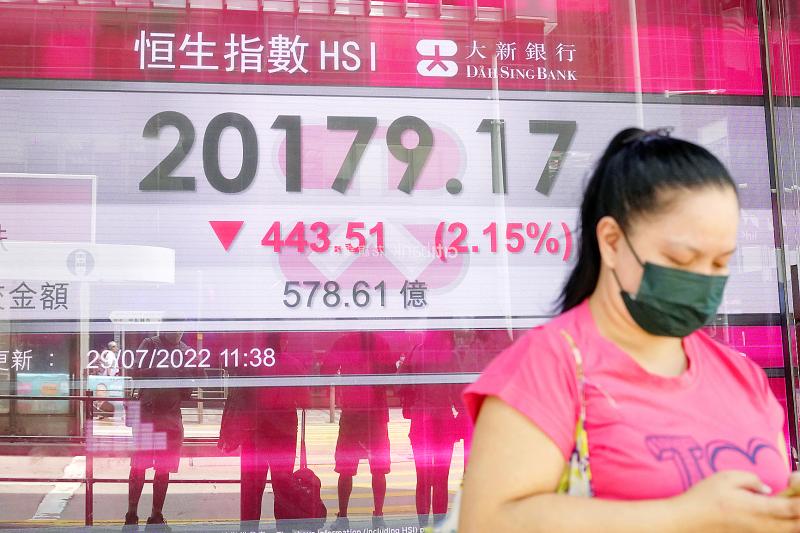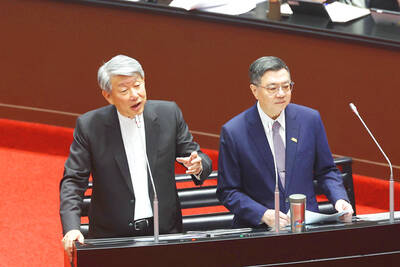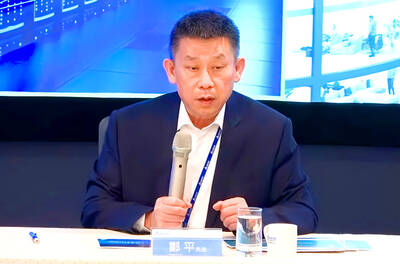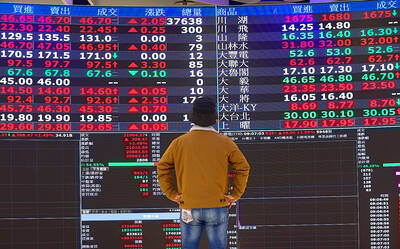Asian shares were mixed on Friday, as Chinese shares sank after leaders acknowledged that the official 5.5 percent growth target for this year would not be met.
Investors appear to have grown more convinced that the US Federal Reserve might temper its aggressive interest rate hikes aimed at taming inflation after the US Department of Commerce reported that the US economy contracted at a 0.9 percent annual pace in the past quarter. That followed a 1.6 percent year-on-year drop in the first quarter.
Investors were also cautiously eyeing regional tensions over China’s stance on Taiwan after US President Joe Biden and Chinese President Xi Jinping (習近平) spoke for more than two hours on Thursday.

China left no doubt it blames the US for a deteriorating relationship, but the White House said the call’s aim was to “responsibly manage our differences and work together where our interests align.”
In Taipei, the TAIEX closed up 108.17 points, or 0.73 percent, at 15,000.07, posting a weekly gain of 0.34 percent. Turnover totaled NT$222.857 billion (US$7.44 billion).
Hong Kong’s Hang Seng Index dropped 2.26 percent to 20,156.51, losing 2.2 percent weekly, while the Shanghai Composite Index shrank 0.89 percent to 3,253.24, declining 0.51 percent from a week earlier after China’s leaders said that the struggling economy would not hit its official growth target of 5.5 percent this year.
The announcement after a Chinese Communist Party planning meeting on Thursday said that Beijing would try to prop up sagging consumer demand, but would stick to strict anti-COVID-19 tactics that have disrupted manufacturing and trade.
It underscores the high cost Xi’s government is willing to incur to stop the virus in a politically sensitive year when he is widely expected to try to extend his term in power.
Elsewhere, South Korea’s KOSPI added 0.67 percent to 2,451.50, rising 2.44 percent weekly, while Australia’s S&P/ASX 200 gained 0.81 percent to 6,945.20, up 2.26 percent from a week earlier, and India’s SENSEX increased 1.25 percent to 57,570.25, posting a weekly gain of 2.67 percent.
Japan’s benchmark Nikkei 225 lost 0.05 percent to 27,801.64, down 0.4 percent on the week, while the broader TOPIX dropped 0.44 percent to 1,940.31, declining 0.8 percent from a week earlier.
Japanese government data showed factory output last month jumped 8.9 percent from the previous month, marking the first rise in three months.
The recent easing of COVID-19 lockdowns in China has helped boost Japanese production.
“On the economic data front, easing China’s restrictions also drove a stronger-than-expected June output for Japan, with China’s reopening potentially having a positive knock-on impact across the region as well into the second half of the year,” said Yeap Jun Rong, market strategist at IG in Singapore.
A surge in COVID-19 infections to record levels in many parts of Japan has raised concern, but Robert Carnell, regional head of research for Asia-Pacific at ING, said that Japan’s second quarter GDP would rebound marginally from the first quarter’s contraction.
Additional reporting by staff writer, with CNA

Taiwanese suppliers to Taiwan Semiconductor Manufacturing Co. (TSMC, 台積電) are expected to follow the contract chipmaker’s step to invest in the US, but their relocation may be seven to eight years away, Minister of Economic Affairs J.W. Kuo (郭智輝) said yesterday. When asked by opposition Chinese Nationalist Party (KMT) Legislator Niu Hsu-ting (牛煦庭) in the legislature about growing concerns that TSMC’s huge investments in the US will prompt its suppliers to follow suit, Kuo said based on the chipmaker’s current limited production volume, it is unlikely to lead its supply chain to go there for now. “Unless TSMC completes its planned six

Intel Corp has named Tasha Chuang (莊蓓瑜) to lead Intel Taiwan in a bid to reinforce relations between the company and its Taiwanese partners. The appointment of Chuang as general manager for Intel Taiwan takes effect on Thursday, the firm said in a statement yesterday. Chuang is to lead her team in Taiwan to pursue product development and sales growth in an effort to reinforce the company’s ties with its partners and clients, Intel said. Chuang was previously in charge of managing Intel’s ties with leading Taiwanese PC brand Asustek Computer Inc (華碩), which included helping Asustek strengthen its global businesses, the company

Power supply and electronic components maker Delta Electronics Inc (台達電) yesterday said second-quarter revenue is expected to surpass the first quarter, which rose 30 percent year-on-year to NT$118.92 billion (US$3.71 billion). Revenue this quarter is likely to grow, as US clients have front-loaded orders ahead of US President Donald Trump’s planned tariffs on Taiwanese goods, Delta chairman Ping Cheng (鄭平) said at an earnings conference in Taipei, referring to the 90-day pause in tariff implementation Trump announced on April 9. While situations in the third and fourth quarters remain unclear, “We will not halt our long-term deployments and do not plan to

The New Taiwan dollar and Taiwanese stocks surged on signs that trade tensions between the world’s top two economies might start easing and as US tech earnings boosted the outlook of the nation’s semiconductor exports. The NT dollar strengthened as much as 3.8 percent versus the US dollar to 30.815, the biggest intraday gain since January 2011, closing at NT$31.064. The benchmark TAIEX jumped 2.73 percent to outperform the region’s equity gauges. Outlook for global trade improved after China said it is assessing possible trade talks with the US, providing a boost for the nation’s currency and shares. As the NT dollar